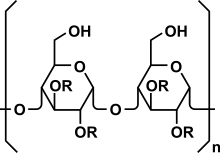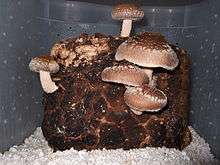AHCC
AHCC is the brand name of an alpha-glucan rich nutritional supplement produced from the mycelia of shiitake (Lentinula edodes) of the basidiomycete family of mushrooms. The compound is a subject of research as a potential anti-cancer agent but has not been conclusively found to treat cancer or any other disease, and there are conflict of interest concerns about the published research.[1][2] AHCC is a popular alternative medicine in Japan.[3]


AHCC is a registered trademark of and manufactured by Amino Up Co., Ltd. in Sapporo City, Hokkaido, Japan. [4]
Development and Chemical composition
AHCC was developed by Amino Up Chemical Co., LTD. and Dr. Toshihiko Okamoto (School of Pharmaceutical Sciences, University of Tokyo) in 1989[5].
Polysaccharides form a large part of the composition of AHCC. These include beta-glucan (β-glucan) and acetylated α-glucan. Acetylated α-glucan, produced by culturing the mushroom mycelia, is unique to AHCC. Approximately 20% of the make up of AHCC is α-glucans.[6]
Glucans are saccharides, of which some are known to have immune stimulating effects.[7]
Potential Mechanisms of Action
The manufacturer of AHCC states that the culturing process utilized in its manufacture favors the release of small bioactive molecules that act as nontoxic agonists for toll-like receptors (TLRs), specifically TLR-4, initiating a systemic anti-inflammatory response. AHCC is believed to bind to TLR-2 and TLR-4, and act as an immune modulator,[8] as Immune cells such as CD4+ and CD8+ T cells and natural killer (NK) cells will produce cytokines by either cytokine stimulation by dendritic cells or ligand binding to TLRs. [9]
Use in Integrative Medicine
AHCC is widely used in Japan and China[10]. It is available to the general public in Japan and China without a prescription and many people use it for general health maintenance and treatment of acute infections.
It is often used as a Complementary and Alternative Medicine (CAM) for immune support[5], as reports in animal and clinical settings have indicated that AHCC is associated with an enhanced response to infection and increased survival.[11][12] AHCC is in some cases also used by those undergoing conventional cancer therapy for its reported immunomodulatory functions. [13]
In Japan, AHCC is the 2nd most popular complementary and alternative medicine used by cancer patients. Agaricus blazei supplements are the most popular, outpacing AHCC use by a factor of 7:1.[3]
Research
Nearly all of the research into AHCC has been funded by the manufacturer, which complicates the discussion of currently available results – independent research is needed to verify them.[2] The mechanism of action of AHCC is poorly understood and there is little known about its safety.[2] As of 2011 clinical research into AHCC has been of poor quality: there are no large-scale studies or randomized controlled trials.[2]
Laboratory research suggests AHCC may have immunostimulatory effects.[2]
AHCC has been proposed as a treatment for cancer, but research into its effectiveness has produced only uncertain and inconclusive evidence.[1] Detailed research is needed into the pharmacology of AHCC before any recommendation of its use as an adjuvant therapy can be made.[2]
Studies have suggested that AHCC supplementation may affect immune outcomes and immune cell populations, suggesting that it has anti-inflammatory effects[14]. Moreover, available data have demonstrated that AHCC may possibly reduce symptoms, improve survival, and shorten recovery time in animal models infected with viruses, bacteria, and fungal infections. [15][16]
See also
- Alternative cancer treatments
- Agaricus blazei mushroom
- Medicinal mushrooms
- Shiitake
References
- "AHCC". WebMD. Retrieved 23 September 2018.
- Shah SK, Walker PA, Moore-Olufemi SD, Sundaresan A, Kulkarni AD, Andrassy RJ (2011). "An evidence-based review of a Lentinula edodes mushroom extract as complementary therapy in the surgical oncology patient". JPEN J Parenter Enteral Nutr (Review). 35 (4): 449–58. doi:10.1177/0148607110380684. PMID 21628606.
It is important to note that the vast majority of the published research on AHCC has been supported by the manufacturer.
- Hyodo I, Amano N, Eguchi K (April 2005). "Nationwide survey on complementary and alternative medicine in cancer patients in Japan". Journal of Clinical Oncology. 23 (12): 2645–54. doi:10.1200/JCO.2005.04.126. PMID 15728227.
- "AHCC®A Standardized Extract of Cultured Lentinula edodes Mycelia – Amino Up". www.aminoup.co.jp. Retrieved 2018-11-16.
- Anil D. Kulkarni; Philip Calder; Toshinori Ito (2016). Clinician's Guide to AHCC. ISBN 978-4-9909264-1-0.
- Ito, Toshinori; Urushima, Hayato; Sakaue, Miki; Yukawa, Sayoko; Honda, Hatsumi; Hirai, Kei; Igura, Takumi; Hayashi, Noriyuki; Maeda, Kazuhisa (2014-03-10). "Reduction of Adverse Effects by a Mushroom Product, Active Hexose Correlated Compound (AHCC) in Patients With Advanced Cancer During Chemotherapy—The Significance of the Levels of HHV-6 DNA in Saliva as a Surrogate Biomarker During Chemotherapy". Nutrition and Cancer. 66 (3): 377–382. doi:10.1080/01635581.2014.884232. ISSN 0163-5581. PMID 24611562.
- Fujii H, Nakagawa T: Novel substance having physiological activity, process for producing the same, and use, U.S. Patent Application Publication, Mar 6, 2003.
- Mallet, Jean-François; Graham, Émilie; Ritz, Barry W.; Homma, Kohei; Matar, Chantal (2015-01-18). "Active Hexose Correlated Compound (AHCC) promotes an intestinal immune response in BALB/c mice and in primary intestinal epithelial cell culture involving toll-like receptors TLR-2 and TLR-4". European Journal of Nutrition. 55 (1): 139–146. doi:10.1007/s00394-015-0832-2. ISSN 1436-6207. PMID 25596849.
- Zhinan Yin; Hajime Fujii; Thomas Walshe (August 2010). "Effects of Active Hexose Correlated Compound on Frequency of CD4+ and CD8+ T Cells Producing Interferon-γ and/or Tumor Necrosis factor-α in Healthy Adults". Human Immunology. 71 (12): 1187–1190. doi:10.1016/j.humimm.2010.08.006. PMID 20732368.
- Cao, Zhiyun; Chen, Xuzheng; Lan, Lan; Zhang, Zhideng; Du, Jian; Liao, Lianming (April 2015). "Active hexose correlated compound potentiates the antitumor effects of low-dose 5-fluorouracil through modulation of immune function in hepatoma 22 tumor-bearing mice". Nutrition Research and Practice. 9 (2): 129–136. doi:10.4162/nrp.2015.9.2.129. ISSN 1976-1457. PMC 4388943. PMID 25861418.
- Ritz, Barry W (2008-08-22). "Supplementation with active hexose correlated compound increases survival following infectious challenge in mice". Nutrition Reviews. 66 (9): 526–531. doi:10.1111/j.1753-4887.2008.00085.x. ISSN 0029-6643. PMID 18752476.
- Nogusa, Shoko; Gerbino, Jeffrey; Ritz, Barry W. (February 2009). "Low-dose supplementation with active hexose correlated compound improves the immune response to acute influenza infection in C57BL/6 mice". Nutrition Research. 29 (2): 139–143. doi:10.1016/j.nutres.2009.01.005. ISSN 0271-5317. PMID 19285605.
- "AHCC® ResearchAHCC🄬の研究 – Amino Up". www.aminoup.co.jp. Retrieved 2018-11-21.
- Mascaraque, Cristina; Suárez, María Dolores; Zarzuelo, Antonio; de Medina, Fermín Sánchez; Martínez-Augustin, Olga (2014-10-02). "Active hexose correlated compound exerts therapeutic effects in lymphocyte driven colitis". Molecular Nutrition & Food Research. 58 (12): 2379–2382. doi:10.1002/mnfr.201400364. ISSN 1613-4125. PMID 25186628.
- Wang, Shuhui; Welte, Thomas; Fang, Hao; Chang, Gwong-Jen J.; Born, Willi K.; O'Brien, Rebecca L.; Sun, Buxiang; Fujii, Hajime; Kosuna, Ken-Ichi (2009-01-13). "Oral Administration of Active Hexose Correlated Compound Enhances Host Resistance to West Nile Encephalitis in Mice". The Journal of Nutrition. 139 (3): 598–602. doi:10.3945/jn.108.100297. ISSN 0022-3166. PMC 2646222. PMID 19141700.
- Aviles, Hernan; O'Donnell, Phyllis; Sun, Buxiang; Sonnenfeld, Gerald (December 2006). "Active Hexose Correlated Compound (AHCC) Enhances Resistance to Infection in a Mouse Model of Surgical Wound Infection". Surgical Infections. 7 (6): 527–535. doi:10.1089/sur.2006.7.527. ISSN 1096-2964. PMID 17233570.